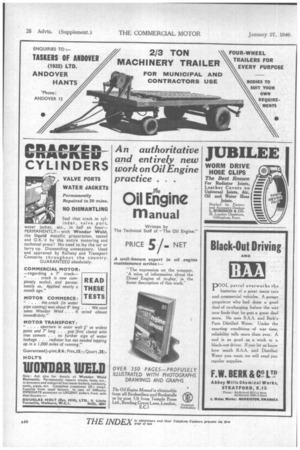Goods-vehicle Registrations Still Under a Cloud
Page 50

If you've noticed an error in this article please click here to report it so we can fix it.
AS intimated in our issue for last week, the number of new vehicles registered in November last was fully in keetting with the tendency that has prevailed for several months past. Whilst the disparity in the figures for the corresponding month of 1937 and 1938 was not so pronounced (that for hackneys was practically stable), nevertheless, it remains a fact that the registration of goods vehicles fen by
194 in the '12 months. The actual total for hackneys in November last was 490, whereas it was 489 a year earlier, whilst the total for goods vehicles was 5,030 against 5,224.
So far as goods vehicles are concerned, the drop in the year in the petrol class was 164, this year's total of 4,743 having to be set against 4,907 for November, 1937. The highspot in this class was touched by the 2-2i-tonnes with a total of 1,501 registrations, the next in order of importance being the 12-cwt.-I-tonnes with 901 registrations, contrasted with 748 in the previous year. The latter was not the only division te show an increase, for the 1-14-tonners also rose, although, in this case, the total of 484 was only 12 above that for November, 1937.
e16 In the other classes in this category, the following registrations took place (last year's totals being given in parenthesis):—Not exceeding 12-cwt., 842 (960) 11-2-tonners, 735 (745); 243-tonners, 139 (187); 3-4-tonners, 111 (131); 4-5-tonuers, 24 (37). Only six vehicles above this limit were registered in November last, in which month no petrol goods vehicle above a 7-ton unladen-weight limit was licensed.
The total for goods oilers showed no change, and, once again, the 4-5-tonner led the field with 50 registrations, being followed by the 6-7-tonner, 2-24tonnes and 3-4-tonner in that order and with little variation. In both years, the registrations in this class totalled 149 vehicles.
The electric vehicle fell from grace somewhat, and with 52 registrations the total was 21 down.
The number of goods vehicles licensed for drawing trailers was 28, 17 of them exceeding 4 tons unladen weight; last year's total was 34. In the multi-wheeled class the five.
wheeler( mechanical-horse type) headed the list with 67 registrations, being followed by the rigid six-wheeler with 66, the articulated type with 43
and, finally, the eight-wheeler with 29. In November, 1937, five-wheelers Were not listed independently, but in that month the six-wheeler came first with 67 registrations, followed by the articulated type with 51, and the eightwheeler with 26.
There were only 68 agricultural vans and lorries registered compared with 87 in November, 1937. Under the heading of agricultural tractors (5s. class), 346 ploughing machines, etc., were licensed, against 268 a year earlier. So far as tractors are concerned, 13 for general-haulage purposes and 10 for agricultural work were registered, last year's comparable figures being 21 and 18, respectively.
In the three classes into which hackney vehicles are divided, the only increase was to be found in that for petrol vehicles, the actual number being 184 against 162 a year earlier.
In the case of hackney oilers, the total at 247 contrasted with 260 in November, 1937. In both years, the highspot was hit by the 48-56-seater with 124 and 180 registrations, respectively. The total for trolleybuses was 59, mainly made up of vehicles exceeding 64-seater capacity; last year the total was 67:
The aggregate figures for the 11 months ended November last show that 61,955 goods vehicles and 8,172 hackney vehicles were registered, the previous year's comparable returns being 70,238 and 7,820 respectively.




















































































